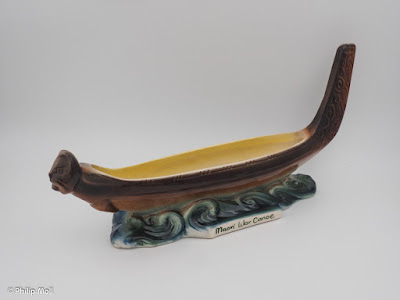'S' is for Souvenirs
What is Titian Studio's Missing S.108 Piece?
Handpainted Souvenir Plate - S.107
You have to be a strong person to not get caught buying at least one souvenir trinket on your travels. The minimum would be a postcard, but there's key rings, kiwi soft toys and tee shirts to entice you. Back in the fifties and sixties, the health consequences of smoking weren’t fully understood, so what could be better than an ashtray. They were practical, small enough to disappear into luggage, and an appreciated item bringing back holiday memories with every flick of ash.
Pre-1957 Cameron Brown's souvenir range was marked on the base with the Titian Studio green slash, and sometimes the product name scratched through a separate green slash. After 1957, the souvenir range was given a 'S' product code and fresh moulds were made.
Images and greetings - ‘Kia Ora’ or ‘Greetings from' would be sgraffito through a black or dark green glaze, exposing the white body underneath. In a 1961 distributor's catalogue they were advertised as ‘S100 - Square Ash Trays 5 Assorted offering a selection of images - Trout, Marlin, Fantail, Kiwi, Māori Chief.' The five images were also offered on the shell ashtray.
Cameron and Dorothy Brown had a particular interest in Māoridom. He designed all the pieces with the deepest respect for Māori culture. While some of these pieces are today considered disrespectful, the Browns would never have considered they’d cause offence. Around the nineteen fifties and sixties there was little, to no understanding of Māori culture or beliefs.
S.102 – Handpainted Māori Warrior and Marble glazed Meres
The Mere is actually in the shape of a Patu. These pieces were decorated with transfers or hand painted. The Mere with the marble glazed is uncommon as they were usually handpainted with a Māori Warrior or a leaping marlin.
There are many combinations of glazes with the most usual being the brown outside, pale yellow inside, and green or blue waves. There are rarer glaze variations including a white matte version. Hemara Hemara, a previous employee of Titian Studio, made his own version of the canoe mould.
There are two versions of the Tiki Face ashtray. The green version below, with the red rings around the eyes was made between 1954 - 1957. It has the 'Titian Studio' green slash on the base. Red glazes tended to be temperamental at high temperatures causing them to change colour or burn away. Through trial and error it was discovered that red nail polish was a suitable replacement in the kiln.
Early version of the Tiki Ashtray
The later version made after 1957 of the Tiki Face ashtray is bigger and chunkier with the decorative carving not as intricate. More colours have been used, including blue for the eyes. The S.105 product code is impressed into the base.
S.105 – Tiki Face Ashtray
To fully appreciate the Wahine Character Jug it needed it's own blog post. Click this link to read the full story about this wonderfully iconic piece.
Both Cameron Brown and his senior hand decorator, Sonia Posterpil used the rounded triangle looking S.107 plate like a canvas, producing many beautiful artworks. In 1964 the Palmerston North City Council commissioned a commemorative plate. Every plate was hand painted by Teddy Rennie using Cameron Brown’s design of Hopwood Clock Tower in The Square. The plate is either white, or black with the picture in reverse.
For more information about these two delightful dishes check out my previous blog - 1959 Auckland Harbour Bridge.
The image is a rudimentary depiction of Maui fishing up New Zealand whilst perched in a dinghy. At each end are petrels with wings outstretched forming handles. In the 1961 G.R. Newgoods catalogue it was advertised as S111 as a ‘Souvenir Sandwich Tray’. It is commonly known amongst collectors as the Maui Platter. I've never see an example with any markings on the back. It would have originally come boxed, and was exempt from sales tax because it was advertised as a tray.
Souvenir
of New Zealand plate – September 1963, Henderson.
Written on the reverse is, 'Made Expressly for Souvenirs-En-Gros by Titian Potteries. Copyright by P H Kok Sept 1963'
P.H.
Kok was an up and coming Maori artist from the South Island. He was to become
quite well known for her ‘Aramoana’ painting. Kok did a design for Titian
Potteries and gave it to them for free, with its use being credited to him. Cam
was disappointed with the picture so redrew it and adjusted the layout. Once
happy with the design he made transfers in blue and white to go on contrasting
coloured plates. There were only about 100 made. Cam jnr isn’t sure who it was made
for.
It’s got great images with Rangitoto, the Auckland Harbour Bridge, the Auckland University clock tower, Mt Ruapehu, Maori scenes and characters, silver fern palms, a Kiwi, and incredibly a representation of one of the Waikato hydroelectric power stations. A very North Island scenic plate. I don’t believe there was one designed for the South Island.
There are many more pieces of souvenir pieces the Browns produced including a barrel mug with an ashtray lid, an Auckland International Airport commemorative mug, and various transfers, and a North Island illustrative plate.
Thanks for dropping by. If you've got the missing S.108 plate I'd love to see it. Please share my blog with others. It would be great to have it promoted and easily found on Google and other search engines.
Happy days,
Louise
©Louise de Varga 2022 - Content and pictures in this blog







.jpg)



.jpg)
.jpg)
.jpg)

.jpg)
.jpg)








Comments
Post a Comment